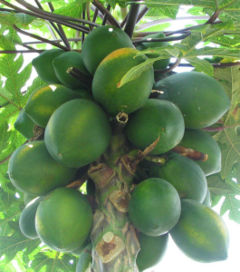Caricaceae
| Standard Cyclopedia of Horticulture |
|---|
|
Caricaceae (from the genus Carica, erroneously supposed to be a native of Caria; or from the Latin meaning a kind of dry fig). Pawpaw Family. Fig. 41. Peculiar trees with straight, rarely branched, palm-like trunks, very abundant milky juice, and a terminal crown of very large, alternate, palmately-lobed, rarely entire, leaves: flowers unisexual, small, nearly regular; sepals 5; petals 5, in the staminate flowers connate, in the pistillate nearly separate; stamens about 10, inserted on the corolla; ovary superior, 1- or 5-celled, many- seeded; styles 5: fruit a large melon-like berry. This is a small family of 2 genera and 27 species, confined to tropical and subtropical America; most abundant in the Andes. The Caricaceae is united with the Passifloraceae by some authors, but is similar only in the fruit. It is also related to the Cucurbitaceae by the fruit. The peculiar habit and abundant milky juice are very distinctive. The large melon-like fruits of Carica Papaya are now cultivated and eaten throughout the tropics; those of other species are also eaten. The milky juice of C. Papaya contains a pepsin-like substance which will curdle milk. This substance will separate the fibers of meat, and hence the leaves and fruit are cooked with too fresh tough meat to make it tender. The juice has also been used as a remedy for dyspepsia. Carica Papaya (South American pawpaw) is commonly grown in greenhouses; and it, as well as two other species, are grown in southern California and Florida in the open.
|
| Caricaceae {{{status}}} Fossil range: {{{fossil_range}}}
| ||||||||||||||||||||||||||||||||||||||||||||||||||||||||||||||||||
|---|---|---|---|---|---|---|---|---|---|---|---|---|---|---|---|---|---|---|---|---|---|---|---|---|---|---|---|---|---|---|---|---|---|---|---|---|---|---|---|---|---|---|---|---|---|---|---|---|---|---|---|---|---|---|---|---|---|---|---|---|---|---|---|---|---|---|
 Carica papaya | ||||||||||||||||||||||||||||||||||||||||||||||||||||||||||||||||||
| Plant Info | ||||||||||||||||||||||||||||||||||||||||||||||||||||||||||||||||||
| ||||||||||||||||||||||||||||||||||||||||||||||||||||||||||||||||||
| Scientific classification | ||||||||||||||||||||||||||||||||||||||||||||||||||||||||||||||||||
| ||||||||||||||||||||||||||||||||||||||||||||||||||||||||||||||||||
| [[{{{diversity_link}}}|Diversity]] | ||||||||||||||||||||||||||||||||||||||||||||||||||||||||||||||||||
| {{{diversity}}} | ||||||||||||||||||||||||||||||||||||||||||||||||||||||||||||||||||
| Binomial name | ||||||||||||||||||||||||||||||||||||||||||||||||||||||||||||||||||
| {{{binomial}}} | ||||||||||||||||||||||||||||||||||||||||||||||||||||||||||||||||||
| Trinomial name | ||||||||||||||||||||||||||||||||||||||||||||||||||||||||||||||||||
| {{{trinomial}}} | ||||||||||||||||||||||||||||||||||||||||||||||||||||||||||||||||||
| Type Species | ||||||||||||||||||||||||||||||||||||||||||||||||||||||||||||||||||
| {{{type_species}}} | ||||||||||||||||||||||||||||||||||||||||||||||||||||||||||||||||||
| Genera | ||||||||||||||||||||||||||||||||||||||||||||||||||||||||||||||||||
| See text | ||||||||||||||||||||||||||||||||||||||||||||||||||||||||||||||||||
| [[Image:{{{range_map}}}|{{{range_map_width}}}|]] | ||||||||||||||||||||||||||||||||||||||||||||||||||||||||||||||||||
| Synonyms | ||||||||||||||||||||||||||||||||||||||||||||||||||||||||||||||||||
| {{{synonyms}}} |
Caricaceae is a family of flowering plants in the order Brassicales, native to tropical regions of Central and South America and Africa. They are short-lived evergreen pachycaul shrubs or small trees growing to 5-10 m tall; many bear edible fruit.
The family comprises five genera and about species:
- Carica – one species Carica papaya (Papaya), Americas
- Cylicomorpha – two species, Africa
- Jacaratia – five species, Americas
- Jarilla – three species, Americas
- Vasconcellea – 20 species, Americas